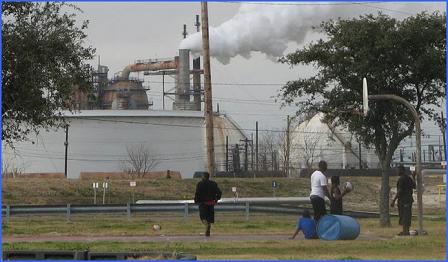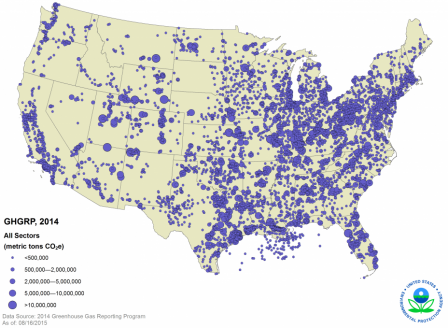EPA Public Engagement Highlights for the Week of October 5, 2015

- Help Highlight Children's Health in October
- New Fenceline Monitoring Rule Protects Families Living Near Refineries
- Join a Greenhouse Gas Reporting Webinar on October 8
- Steam Electric Rule Reduces Toxic Discharge in Waterways
Help Highlight Children's Health in October
 Children are often more vulnerable to pollutants than adults.Children’s Health Month is celebrated each October to raise awareness about the importance of protecting the health of our nation’s children. EPA is working with parents, teachers, healthcare providers, and caregivers to promote healthy environments where children live, learn and play.
Children are often more vulnerable to pollutants than adults.Children’s Health Month is celebrated each October to raise awareness about the importance of protecting the health of our nation’s children. EPA is working with parents, teachers, healthcare providers, and caregivers to promote healthy environments where children live, learn and play.
Recent rules show EPA’s dedication to protecting children’s health. The updated worker protection standard prohibits anyone under the age of 18 from working with harmful pesticides. Additionally, the strengthened ozone standards better protect vulnerable populations, including children, from the adverse health effects of smog. Learn what you can do to protect your child's health.
Join EPA for events across the country to recognize Children's Health Month.
New Fenceline Monitoring Rule Protects Families Living Near Refineries
 The emission reductions from this rule will lower the cancer risk from refineries for 1.4 million people.EPA recently updated emissions standards for petroleum refineries, instituting the first ever fenceline monitoring requirements. This rule requires toxic air pollutants to be monitored and controlled at the fenceline of refineries in order to ensure that they are appropriately managing their emissions, better protecting the communities and families located near these facilities.
The emission reductions from this rule will lower the cancer risk from refineries for 1.4 million people.EPA recently updated emissions standards for petroleum refineries, instituting the first ever fenceline monitoring requirements. This rule requires toxic air pollutants to be monitored and controlled at the fenceline of refineries in order to ensure that they are appropriately managing their emissions, better protecting the communities and families located near these facilities.
Exposure to toxic air pollutants from refineries can cause respiratory problems and other serious health issues, and can increase the risk of developing cancer. Read a blog post by Matthew Tejada, Director of EPA's Office of Environmental Justice, about the new fenceline monitoring rule.
Join Greenhouse Gas Reporting Webinar on October 8
 Find out more about the 8,000+ facilities and suppliers that reported GHG in 2014.Greenhouse Gas Reporting Program (GHGRP) collects data about emissions from the largest sources of greenhouse gases in the United States. GHGRP recently published the emissions data for reporting year 2014. With this dataset, GHGRP now has five years of high-quality data that can be used to track the largest sources of greenhouse gas pollution.
Find out more about the 8,000+ facilities and suppliers that reported GHG in 2014.Greenhouse Gas Reporting Program (GHGRP) collects data about emissions from the largest sources of greenhouse gases in the United States. GHGRP recently published the emissions data for reporting year 2014. With this dataset, GHGRP now has five years of high-quality data that can be used to track the largest sources of greenhouse gas pollution.
EPA is hosting a webinar on Thursday, October 8 at 12:00 p.m. EDT to discuss the 2014 data and to demonstrate how to search and sort facility data with GHGRP's tool.
Steam Electric Rule Reduces Toxic Discharge Into Waterways
 EPA's rule will reduce the discharge of toxic pollutants into America's waterways by 1.4 billion pounds annually.Each year, steam electric plants discharge nearly 65,000 pounds of lead, 79,200 pounds of arsenic, and millions of pounds of other harmful substances that negatively affect the health of Americans. Steam electric power plant discharges occur upstream or close to 100 public drinking water intakes and in proximity to nearly 2,000 public wells across the US.
EPA's rule will reduce the discharge of toxic pollutants into America's waterways by 1.4 billion pounds annually.Each year, steam electric plants discharge nearly 65,000 pounds of lead, 79,200 pounds of arsenic, and millions of pounds of other harmful substances that negatively affect the health of Americans. Steam electric power plant discharges occur upstream or close to 100 public drinking water intakes and in proximity to nearly 2,000 public wells across the US.
EPA recently finalized a rule that will set the first federal limits on the levels of toxic metals in wastewater that can be discharged from power plants. This rule is expected to reduce the amount of toxic metals, nutrients, and other pollutants that steam electric power plants are allowed to discharge by 1.4 billion pounds. Learn more about the Steam Electric Rule.
